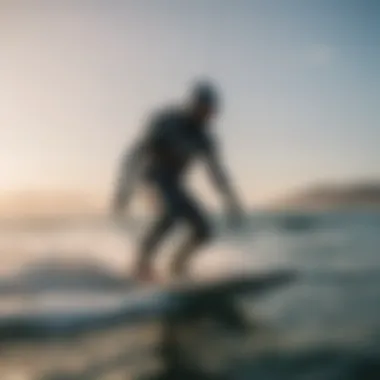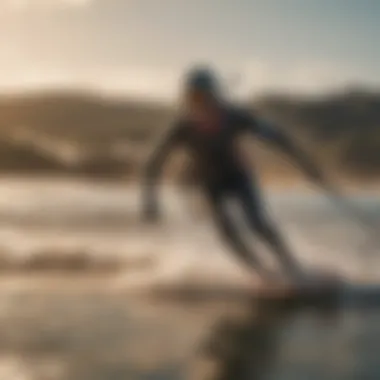Exploring Top Kiteboarding Companies and Trends


Intro
Kiteboarding is not just an extreme sport; it's a blend of freedom, thrill, and a connection with nature that beckons enthusiasts from all walks of life. Sitting at the heart of this exciting activity are the pioneering companies that define the industry through innovation and quality. The influence these brands have is not just about riding the waves; it's about the culture that surrounds kiteboarding, community connectivity, and pushing the boundaries of what's possible.
In this article, we will delve into the world of leading kiteboard companies, scrutinizing their historical developments, the cutting-edge products they offer, and how they've impacted both the safety and sustainability practices within the sport. As we dissect these notable players, we'll uncover the competitive dynamics of the market, revealing trends and innovations that have made kiteboarding what it is today. Furthermore, we'll emphasize the vital aspects of brand reputation, customer loyalty, and the urgency of maintaining safety standards in modern kiteboarding. This comprehensive analysis aims to equip both newbies and seasoned riders with insights that can refine their kiteboarding experiences.
Prologue to Kiteboarding Companies
The kiteboarding industry has seen a remarkable shift over the last few decades, evolving from a niche sport to a mainstream activity. Recognizing the leading companies in this sector is crucial, as it helps enthusiasts navigate the vast offerings available today. Understanding these companies provides insights into their innovations, marketing practices, and contributions to safety and sustainability, which are parameters that define the overall experience of kiteboarding.
Particularly for newcomers, selecting the right kite and board can be daunting without a grasp of the market. Each company presents unique styles, technological advancements, and philosophies that cater to diverse skill levels and preferences. This exploration is not just about the products themselves; it’s about how these companies shape the sport’s future and foster a community around it.
The Evolution of Kiteboarding
Kiteboarding, originally gaining traction in the early 1990s, has roots in both surfing and paragliding. Early adopters used modified kites to surf the waves. However, the progression in design and safety features has helped propel kiteboarding into the sporting spotlight. The distinct evolution can be traced through various technological milestones:
- Early Beginnings: Initial designs were rudimentary, relying heavily on experimentation. Kites lacked stability and control.
- Development of LEI Kites: The introduction of Leading Edge Inflatable kites brought stability and safety, massively changing the game.
- Performance Enhancements: As the sport grew, so did the focus on materials and aerodynamic designs, allowing for better lift and versatility across different water conditions.
This evolution is emblematic of the industry's responsiveness to user needs and technological advancements, reflecting a commitment to enhancing the kiteboarding experience.
Understanding the Market Landscape
The kiteboarding market today is bustling with competition, showcasing a host of players, each vying for a share. Understanding this landscape involves recognizing key drivers and barriers affecting growth and consumer choices.
- Market Demand: The surge in interest around adventure sports has led to increased demand for kiteboarding equipment. Reports show that more individuals are taking an interest in water sports, thus broadening the customer base.
- Economic Factors: Economic fluctuations can influence discretionary spending, making it essential for brands to adopt strategies that resonate with potential purchasers.
- Regional Popularity: Different regions have varying levels of popularity for kiteboarding, affected by local weather patterns, beaches, and cultural acceptance of such extreme sports.
"The kiteboarding market is not just about equipment; it's about creating memorable experiences that resonate with enthusiasts worldwide."
Emphasizing where we're headed allows kiteboarders, whether novices or seasoned riders, to appreciate the strides made and the journey yet to come.
Key Players in the Kiteboarding Industry
Understanding the key players in the kiteboarding industry is crucial for anyone looking to navigate the expansive waters of this thrilling sport. These companies not only shape the market with their products but also influence trends and push for innovations that can elevate the experience for riders. The competition among these brands drives advancements, leading to better equipment in terms of performance, safety, and user experience.
Among these leading companies, some stand out due to their history, commitment to quality, and loyal customer followings. Their influence is felt not only in the products but also in how they contribute to the kiteboarding community and support its sustainability initiatives.
Cabrinha Kites
Cabrinha Kites is a longstanding name in the kiteboarding world, known for its dedication to performance and innovation. Founded by the legendary kiteboarder Pete Cabrinha, the brand has managed to resonate with both beginners and seasoned riders.
Their line includes the popular Switchblade and Doctor kites, designed for a variety of riding styles, from freestyle to wave riding. The Switchblade kite, for instance, is tailored for versatility, making it a favorite for many. Many users praise it for its stability and ease of use, allowing newcomers to feel confident while also meeting the needs of experienced riders.
Cabrinha also focuses heavily on safety features, which is vital in such an extreme sport. This commitment to safety can set them apart in a crowded market. Overall, Cabrinha is not just creating products; they are shaping the way riders interact with the kiteboarding environment.
Naish Kiteboarding
Naish Kiteboarding has carved its name in the industry with a blend of quality, innovation, and performance focus. Founded in the early 1990s by Robby Naish, who is a well-respected figure in windsurfing and kitesurfing, the company is relentless in its approach to product development.
The Naish Pivot, a flagship model, exemplifies their philosophy. It’s known for its responsive handling and adaptability, suitable for a range of conditions. Users often highlight its consistent performance, which can be a game-changer on the water. Customers appreciate not just the products but also the brand’s approach to riding culture, providing a sense of community and belonging.
Naish is committed to sustainability. Their initiatives range from sourcing materials responsibly to supporting ecological efforts, which resonates well with today’s environmentally conscious consumers.
Slingshot Sports


Slingshot Sports is recognized for pushing the envelope in terms of design and technology. Specializing in not just kites but also boards and accessories, Slingshot has made waves, especially with their intuitive kite designs. Their RPM kite is a standout; it's versatile and performs admirably in different conditions. Riders often note its ease of use during tricks, which enhances the overall experience.
Besides performance, their gear durability is also worth highlighting. They focus on materials that withstand the test of time, ensuring that enthusiasts can hit the water with confidence without frequently worrying about replacements.
Moreover, Slingshot has a vibrant community aspect, often encouraging riders to connect and share their experiences, further enriching the kiteboarding scene.
Ozone Kites
Ozone Kites has made its mark with a relentless emphasis on quality and performance. The company prides itself on utilizing advanced technology and rigorous testing protocols to develop its products. Their Rev and Edge kites are prime examples of their mastery, known for stability and precision.
Users frequently laud Ozone for how they seamlessly integrate performance across various disciplines, whether it’s racing or freestyle. What sets them apart, though, is their commitment to a sustainable production process. They have invested in practices that minimize their environmental footprint while enhancing the quality of their products, making them a hit for eco-minded kiteboarders.
F-One Kites
F-One Kites might not be the oldest player in the game, but it has quickly gained a reputation for quality and style. Their products typically strike a balance between performance and aesthetics, making them visually appealing as well as functional. The Bandit kite series, especially, is noteworthy for its stability during intense conditions, making it a go-to for many adventurers.
F-One continuously strives to innovate. They have introduced features that can enhance user experience, such as improved control systems that allow for better handling. The brand is also active in supporting community events and environmental initiatives, which helps solidify its standing among enthusiasts that value both performance and purpose in their gear.
Choosing the right kiteboarding equipment is not merely about brand names. However, understanding these key players can help riders make informed decisions about their gear, ensuring they have the best possible experience on the water.
Product Offerings and Innovations
The depth of kiteboarding’s evolution is reflected in the variety of products offered within the industry. Understanding this niche is not just about knowing the brands; it’s about delving into what they produce and the innovations they introduce. This chapter covers kites, boards, and the latest technological advancements, shedding light on why these offerings matter.
Types of Kites
Kite design has come a long way, and there are three main types to focus on: foil kites, LEI kites, and hybrid kites. Each type has its own place and appeal in the kiteboarding community.
Foil Kites
Foil kites have a structure that features an airfoil shape, which provides lift while in motion. Because they are usually lighter, they perform well in low wind conditions, making them an attractive choice for many riders. Riders appreciate the way foil kites handle, especially in unpredictable winds. They may not provide the same power as LEI kites in strong winds, but they shine with efficiency and ease of control. However, a downside is that they can be a bit more complex to set up.
LEI Kites
LEI kites, or Leading Edge Inflatable kites, are well-known for their durability and ease of use. Riders often prefer them for their wide range of performance in different wind conditions, from light breezes to challenging gusts. The unique benefit is the way they hold their shape to maximize power, making it easier for riders to catch bigger air. What might deter some is their size and weight, which can be cumbersome for transport and setup.
Hybrid Kites
Hybrid kites take the best of both worlds, leading to a versatile design that caters to a wide array of conditions. They combine features from both foil and LEI kites, often giving the rider a balanced experience. For instance, many hybrid kites retain the efficiency of a foil kite while providing the reliability of LEI. The downside is that they might not excel in specific conditions as much as their specialized counterparts do.
Kiteboards and Accessories
Just as kites are pivotal in the kiteboarding experience, so too are the boards and accessories. This section highlights directional boards, twin-tip boards, and essential control bars and lines.
Directional Boards
Directional boards are crafted primarily for use in surf and downwind scenarios. Their design typically allows the rider to use them in a single direction, mimicking the feel of surfing. This type of board is popular among experienced riders who seek to harness the power of waves. However, a downside is that they may not be as versatile in flat-water conditions compared to twin-tip boards.
Twin-Tip Boards
Twin-tip boards are appreciated for their flexibility and versatility. These boards can be ridden in either direction, making them ideal for tricks and jumps. The key characteristic is their design that allows for easy transitions while doing aerial maneuvers. Although they might not perform as well in big waves like directional boards, their adaptability makes them a staple in many riders' quivers.
Control Bars and Lines


Control bars and lines serve as the lifeline between the rider and the kite. A solid setup aids in control, steering, and responsiveness while in flight. The best feature here is the range of customization available, from bar lengths to line types. However, finding the right setup is crucial for performance, as mismatched components can lead to instability.
Technological Advancements
The kiteboarding landscape is ever-evolving, thanks to material innovations, production techniques, and safety enhancements. These advancements shape the future of kites and boards, making the sport both safer and more exciting.
Material Innovations
Innovative materials have changed the game, allowing for lighter, stronger, and more durable kites and boards. The use of ripstop fabrics in kite construction, for instance, enhances tear resistance and prolongs their life. Riders may find newer materials can withstand intense conditions far better than older models, though some may come at a higher cost.
Production Techniques
Production techniques have become increasingly sophisticated, employing advanced methods that enhance quality and efficiency. Techniques like precision cutting and heat sealing are now standard in many manufacturing processes, allowing for better durability and performance consistency. Nevertheless, transitioning to more advanced manufacturing processes might require significant investment and could alter production timelines.
Safety Enhancements
Safety in kiteboarding has always been paramount, and new enhancements continue to emerge in gear design. Features such as quick-release mechanisms on control systems provide riders with the ability to detach quickly in emergencies. The challenge remains, however, in ensuring that these safety features are intuitively designed so that all riders can take full advantage of them under pressure.
In summary, the product offerings in kiteboarding not only reflect technological advancements but also cater to the diverse needs of riders from novice to expert. The quandary for many is balancing the thrill of the sport with the necessity of safety, ultimately shaping the landscape of kiteboarding gear.
Brand Reputations and Customer Experiences
Brand reputations and customer experiences play a vital role in the kiteboarding market, influencing purchasing decisions and shaping the competitive landscape. A kiteboarding company’s reputation is built on its history, quality of products, customer service, and the community’s perception. With numerous options available, enthusiasts often find themselves making choices based on what they hear and read about a brand rather than firsthand experience. This makes it crucial for companies to maintain a positive image and to engender trust among their customers.
Customer Loyalty Trends
Understanding customer loyalty trends in kiteboarding involves examining how and why kiteboarders stick to specific brands. Many factors contribute to loyalty, including product performance, customer service experiences, and community engagement.
For instance, a brand that consistently innovates its kite technology may attract enthusiasts who are looking for cutting-edge performance. Likewise, those who participate in local kiteboarding events often develop brand affiliations based on the recommendations of fellow riders.
Some notable elements that can drive loyalty are:
- Consistent Quality: When a brand consistently produces high-quality products, customers are likely to repurchase from that company.
- Engagement Strategies: Brands that connect with their communities, whether through events or social media, foster loyalty by making customers feel like part of a family.
- Effective Support: Providing excellent customer service ensures that customers are not left stranded with questions or issues, further strengthening brand loyalty.
Impact of User Reviews
User reviews carry significant weight in the kiteboarding industry, shaping perceptions and influencing potential buyers. Kiteboarders often take to platforms like Reddit and Facebook to share their experiences, creating a wealth of user-generated content. These reviews serve as honest reflections of product performance and customer service.
- Word of Mouth: Negative experiences can spread like wildfire. A disgruntled customer on social media can sway public opinion, potentially damaging a brand’s reputation.
- Detailed Evaluations: Many kiteboarders articulate their thoughts in detail, touching on aspects like durability, ease of use, and performance under different conditions. These insights are invaluable for prospective buyers.
- Bargaining Chip: Companies can leverage positive reviews as marketing tools. A well-placed testimonial from a pro rider or an enthusiastic customer can enhance credibility and allure.
"A kiteboarder often relies more on peer reviews than on advertisements. In this sports niche, authenticity matters more than lofty promises."
In summary, brand reputations and customer experiences are intricately linked to the success of kiteboarding companies. Understanding and responding to customer loyalty trends and user reviews not only helps brands secure their market position but also cultivates a thriving kiteboarding community.
The Role of Communities in Kiteboarding
Communities play a pivotal role in the kiteboarding world, shaping not just the culture of the sport but also its evolution and accessibility. These networks of enthusiasts, whether online or in person, create a rich tapestry of support for both new and seasoned kiteboarders. Communities promote learning, safety, and a shared passion for the thrill of riding the wind and water. Through gatherings, forums, and competitions, they help fuel individual and collective growth in this exhilarating sport.
Kiteboarding Associations
Kiteboarding associations serve as the backbone of the sport’s community. These organizations typically focus on various objectives—promoting the sport, ensuring safety standards, and providing educational resources to new riders. They often organize training programs and workshops, which can be invaluable for new athletes. For instance, IKO (International Kiteboarding Organization) does a fantastic job at this, offering structured lessons and certifications worldwide. This helps aspiring kiteboarders learn safely and effectively.
"Kiteboarding associations not only teach the skills needed but also foster a profound respect for the ocean and the environment, which is crucial for the future generations."
In many regions, local kiteboarding clubs emerge under these national or international umbrellas. They often facilitate the sharing of resources and experiences among kiteboarders. This mutual support creates an atmosphere where everyone is encouraged to progress—be it through sharing tips, tricks, or simply gathering to ride together. Notably, these associations often champion sustainable practices, making sure that the community is conscious about its impact on the environment.


Local Competitions and Events
When it comes to fostering a sense of community, local competitions and events are the name of the game. These gatherings provide a platform for kiteboarders to showcase their skills, learn from one another, and bond over a shared passion. They often lead to the creation of friendships that extend beyond the competition itself, as participants celebrate achievements and share knowledge in a lively atmosphere.
Many competitions are centered around specific locations, allowing communities to bring together kitesurfers from various backgrounds. For instance, events like the Kite Masters or regional championships offer thrilling competition while promoting local tourism and engagement.
Additionally, these events often include workshops, fun races, and even social gatherings that allow for networking among participants. The communal aspect is palpable—people cheering for friends and learning from seasoned athletes in real-time. Such interactions are instrumental in reducing barriers to entry, especially for newcomers who might feel intimidated by the sport’s perceived complexities.
Overall, the role of communities in kiteboarding extends far beyond the actual riding. They are integral to nurturing a safe, supportive, and dynamic environment that embraces diversity, innovation, and passion for the sport.
Sustainability in the Kiteboarding Sector
The kiteboarding industry, much like the winds on which it relies for propulsion, is subject to change and evolution. As concerns over climate change and environmental damage become more pressing, sustainability within the kiteboarding sector has grown into a pivotal topic. This section delves into the essential elements driving sustainability, the advantages that come from it, and the compelling reasons for kiteboard companies to embrace responsible practices.
Environmental Considerations
In any sport that depends on nature, the environmental impact cannot be overlooked. Kiteboarding, which takes place on beaches, lakes, and open waters, has unique challenges and opportunities when you think about sustainability. For instance, the manufacturing processes of kites and boards often involve materials like plastics and synthetic fibers. These materials are durable but can also contribute significantly to pollution if not managed properly.
To counteract these issues, some companies are exploring biodegradable materials and sustainable sourcing. Initiatives like using recycled plastics in their products not only lessen waste but also promote a circular economy within the industry. For example, Ozone Kites has made strides in implementing sustainable materials into their manufacturing processes. By focusing on reducing their carbon footprint, they set a precedent that others in the industry can follow.
Moreover, the locations where kiteboarding takes place are often sensitive ecosystems. Beach clean-ups and partnerships with local environmental organizations have become increasingly common among respectful brands. Not only do these efforts mitigate damage, but they also strengthen community bonds.
"The surf and wind don’t exist in silos; they’re part of a larger environmental puzzle that kiteboarders must respect and protect."
Ethical Manufacturing Practices
Ethics in manufacturing goes beyond just materials—it encompasses the entire supply chain. Many kiteboarding companies have come to realize that consumers today prefer brands that not only deliver high quality but also uphold humane and sustainable practices. Leading brands have started to scrutinize their labor conditions to ensure fair wages and safe working environments.
For instance, Cabrinha Kites has led the way in advocating for factory transparency. By openly sharing their manufacturing processes and location, they promote accountability. Their approach allows consumers to understand the journey of their equipment, from raw materials to finished products.
Some companies are also adopting fair trade principles, ensuring that workers are not exploited and that their rights are protected. This moral commitment doesn’t just foster respect—it builds brand loyalty that can set a company apart in a crowded market.
Investing in ethical manufacturing is less about compliance and more about creating a culture that values people and the planet. This investment can lead companies to create better products while aligning with a growing consumer awareness around ethical consumption.
In summary, sustainability in kiteboarding is a multidimensional topic that encompasses environmental responsibility and ethical practices. Educating consumers and encouraging companies to evolve will create a more sustainable future for the entire industry.
The End: The Future of Kiteboarding Companies
As we look toward the future of kiteboarding companies, it becomes clear that several interconnected factors will shape the industry's trajectory. From shifts in consumer preferences to advancements in technology, the landscape is continually evolving. Emerging trends, along with predictions for market growth, paint a vivid picture of where kiteboarding might head in the coming years.
Emerging Trends
One of the most significant trends in kiteboarding is the increasing focus on sustainability. As environmental awareness grows, companies are seeking ways to reduce their carbon footprints. This includes using eco-friendly materials in manufacturing and prioritizing sustainable production practices. For instance, some companies are experimenting with bio-based resin and recycled fabrics in their kites, catering to a more environmentally conscious consumer base.
Another noteworthy shift is the rise of the "smart" kiteboard. Innovations in technology are leading to connected devices that track performance metrics, enhancing the overall experience. This trend appeals particularly to younger audiences who are keen on data analytics. Incorporating GPS and smart sensors into kiteboards could very well revolutionize the way enthusiasts train and compete.
Furthermore, as kiteboarding attracts a broader demographic, from casual weekend warriors to serious athletes, brands are diversifying their product lines. Companies are beginning to offer tailored packages that combine kites, boards, and accessories suitable for different skill levels.
Predictions for Market Growth
Looking ahead, the kiteboarding market is poised for considerable growth. Analysts suggest that as more beach towns and resorts invest in kiteboarding infrastructure, the number of participants in the sport will increase. The accessibility of kiteboarding lessons and equipment rentals will likely contribute to this growth.
Moreover, with social media platforms playing a vital role in promoting extreme sports, kiteboarding companies are harnessing influencer marketing to reach new audiences. By partnering with well-known personalities in the sport, brands can leverage visibility to attract new customers eager to join the waves.
In terms of the economic aspect, the kiteboarding market could see a rise in overall revenue. With advancements in technology and an increase in global interest, the unique experience that kiteboarding offers is sure to entice a wider audience. As more individuals seek thrilling adventures, the inclination to invest in quality kiteboarding gear will likely drive businesses in this sector to innovate further.
"As kiteboarding continues to evolve, understanding these trends and predictions can empower both companies and consumers to make informed decisions."
In summary, the future of kiteboarding companies is robust and filled with opportunities. Sustainability will become more than just a buzzword; it will be essential. Smart technology will change the landscape of the sport, and the market will expand as kiteboarding garners greater interest from diverse demographics. For those within the industry, staying ahead of these trends will be crucial in ensuring their relevance and success.













